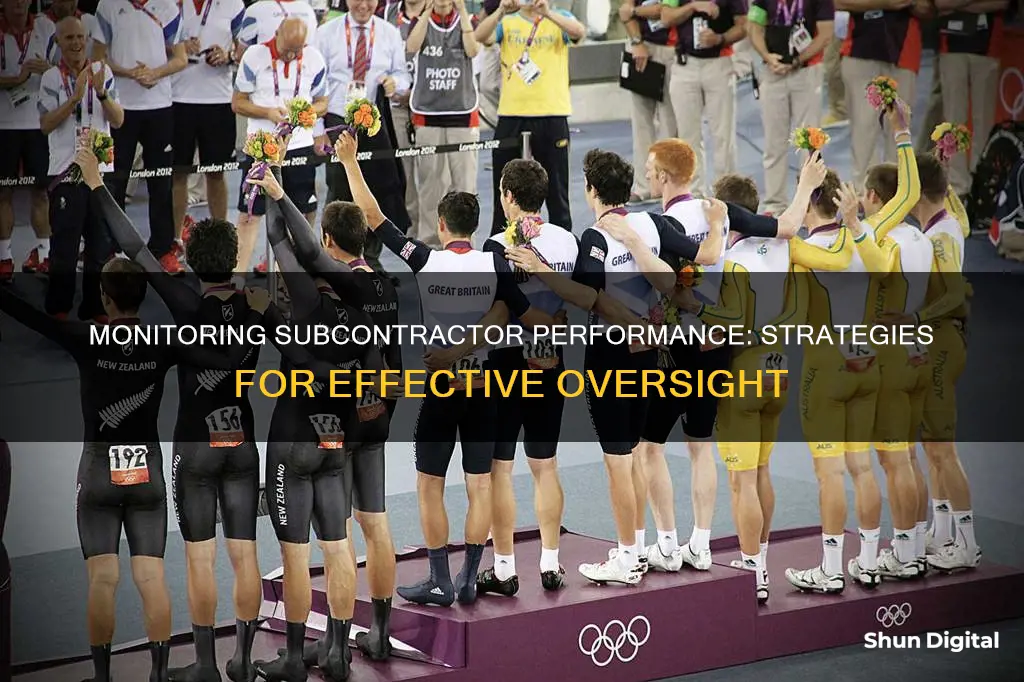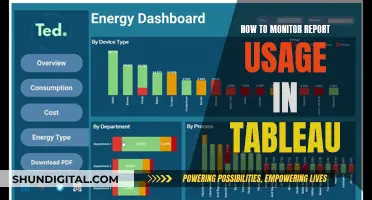
Monitoring subcontractor performance is a critical aspect of ensuring the success of any project. Subcontractors who perform well help keep the building schedule moving, while underperformance can cause costly delays. To avoid this, it is important to establish clear expectations and deliverables from the outset, conduct regular site visits and inspections, and maintain open lines of communication. In addition, key performance indicators (KPIs) and client feedback can provide valuable data and insights to help evaluate subcontractor performance. By tracking metrics such as timeliness, cost efficiency, quality of work, and safety compliance, businesses can identify areas for improvement and address any issues promptly.
| Characteristics | Values |
|---|---|
| Regular communication | Regular communication and feedback sessions help ensure that subcontractors are aligned with the project's objectives, addressing any concerns or challenges early on. |
| Site visits | Site visits or inspections allow businesses to assess the quality of work being performed, adherence to safety protocols, and overall progress on-site. |
| Client feedback | Seeking input from clients who have directly interacted with the subcontractor provides valuable insights into their professionalism, responsiveness, and overall satisfaction with the work performed. |
| Safety | Safety compliance and safety record are important. |
| Financials | Financial solvency is important. |
| Equipment | Subcontractors should have access to the right equipment. |
| Staffing | Staffing numbers and expertise are important. |
| Budget/schedule | The subcontractor should be able to draw up a complete budget and schedule for the project. |
| Track record | The subcontractor's previous work and references are important. |
| Payment terms | Payment terms should be clear. |
| Statement of work | A statement of work should lay out the exact scope of work, including deliverables and deadlines. |
| Provisions | Provisions are important in case of a breach of contract. |
| Rights and duties | Rights and duties should be clearly outlined. |
| KPIs | Key Performance Indicators (KPIs) are important for evaluating subcontractor performance. |
What You'll Learn

Define expectations and requirements
Before hiring a subcontractor, it is imperative to clearly define your expectations and requirements to ensure a successful project. This includes specifying the scope, schedule, quality, and safety of the work to be carried out. A well-defined contract with clear terms, milestones, and penalties for non-compliance is essential for managing subcontractor performance. Here are some key aspects to consider:
Scope of Work
Clearly outline the specific tasks and deliverables expected from the subcontractor. Define the nature and extent of the work, including any special requirements, standards, or specifications that need to be met. This ensures that both parties are on the same page regarding the project's scope and helps prevent misunderstandings or scope creep during the project.
Schedule and Timelines
Establish clear timelines and milestones for the project. Define key dates, deadlines, and expected completion times for different phases of the work. Consider including a planned daily average progress or expected daily productivity rate in the contract to monitor incremental progress effectively. This allows for regular tracking of the subcontractor's performance and identifies potential delays or deviations from the planned schedule.
Quality Expectations
Communicate your quality standards and expectations to the subcontractor. Define the level of workmanship, attention to detail, and level of accuracy required for the project. By setting clear quality expectations, you can ensure that the subcontractor understands the level of quality you desire and can deliver work that meets or exceeds these standards.
Safety Protocols
Outline the safety regulations, practices, and protocols that must be adhered to during the project. Emphasize the importance of safety compliance and ensure that the subcontractor has a good safety record and proof of safety compliance. Include safety performance as a key metric in your evaluation process to hold the subcontractor accountable for maintaining high safety standards throughout the project.
Budget and Cost Constraints
Define the budget and cost constraints for the project, including payment terms and expected expenditures for materials, labour, and other relevant costs. Ensure that the subcontractor provides a detailed budget breakdown and cost estimate. Regularly monitor cost performance to ensure that the project stays within the allocated budget and identify any potential cost overruns.
Communication Protocols
Establish clear communication protocols and expectations. Define the frequency and methods of communication, such as weekly meetings, regular progress reports, or the use of specific communication channels. Open and effective communication ensures that both parties stay aligned with project objectives and enables prompt addressing of any concerns or challenges that may arise.
By defining clear expectations and requirements, you set the foundation for a successful collaboration with your subcontractors. It promotes mutual understanding, helps prevent issues, and fosters a collaborative environment focused on delivering high-quality work that meets your standards and satisfies your clients.
Effective Ways to Remove Libre Glucose Monitors
You may want to see also

Monitor progress and performance
Monitoring the progress and performance of subcontractors is a critical aspect of ensuring the success of any project. Here are some strategies and actions to help you effectively monitor and manage your subcontractors' progress and performance:
Set Clear Expectations and Goals
Before starting the project, establish specific goals, benchmarks, and expectations. Clearly define the scope, schedule, quality standards, and safety protocols that the subcontractor is expected to adhere to. This provides a reference point for evaluating their performance throughout the project.
Utilize Subcontractor Management Software
Incorporate subcontractor management software or quality control (QC) software solutions to streamline the monitoring process. These tools can help you track and evaluate key performance indicators, such as timelines, cost efficiency, quality of work, and safety compliance. The software can also provide real-time updates and indicators of potential delays, allowing you to take proactive measures.
Regular Site Visits and Inspections
Conduct regular site visits and inspections to assess the quality of work, safety adherence, and overall progress. This hands-on approach fosters transparency, accountability, and a collaborative environment. It also enables you to identify areas for improvement and provide immediate feedback to the subcontractor.
Track Key Performance Indicators (KPIs)
Identify relevant KPIs for your project, such as timeliness, cost efficiency, quality of deliverables, safety compliance, and customer satisfaction. Track these metrics over time to identify trends and deviations from expected standards. This data-driven approach will enable you to make informed decisions and address any issues proactively.
Regular Communication and Feedback
Establish regular communication channels with the subcontractor to ensure they remain aligned with the project's objectives. Hold weekly meetings to discuss milestones, benchmarks, challenges, and expectations. Provide feedback and guidance as needed, and maintain open lines of communication through company messaging apps or dedicated communication channels.
Client Feedback
Solicit feedback from clients who have interacted directly with the subcontractor. This provides valuable insights into their professionalism, responsiveness, and overall satisfaction with the work performed. Actively seek client feedback at different stages of the project to gain a comprehensive understanding of the subcontractor's performance.
Evaluate and Recognize Achievements
At the end of the project or upon reaching milestones, evaluate the subcontractor's performance against the predefined KPIs and criteria. Recognize and appreciate their achievements and contributions to the project. This can include positive feedback, testimonials, referrals, awards, or bonuses. Building trust and loyalty will foster long-term partnerships.
Identify Areas for Improvement
Use the performance data and feedback to identify areas where both your organisation and the subcontractor can improve. Review the strengths and weaknesses of the subcontractor and set goals for enhancing their skills, processes, or systems. Regularly reflect on your own performance as well to identify areas where you can enhance your communication, coordination, and supervision skills.
Convincing Mom: Broken Monitor Confessions and Strategies
You may want to see also

Evaluate results and outcomes
Evaluating the results and outcomes of your subcontractors' work is a crucial step in the monitoring process. Here are some detailed guidelines to help you effectively evaluate the results and outcomes of subcontractor performance:
Determine Key Performance Indicators (KPIs)
Before evaluating subcontractor performance, it is essential to establish clear KPIs that will serve as the criteria for assessment. These KPIs should be tailored to your specific business needs and can include metrics such as timeliness, cost efficiency, quality of work, adherence to safety protocols, customer satisfaction, and responsiveness. By defining these indicators, you can set clear expectations and objectives for your subcontractors.
Collect Quantitative Data
Utilize tools such as inspection forms, checklists, scoring and ranking processes, and reporting tools to gather quantitative data on subcontractor performance. Compare the planned daily average progress with the actual daily progress achieved. This will allow you to identify any deviations from the expected standards and address them promptly. Additionally, track metrics such as the number of corrective actions, material returns due to supplier issues, and warranty issues attributed to specific trades.
Solicit Client Feedback
Client feedback is invaluable in understanding the professionalism, responsiveness, and overall satisfaction with the subcontractor's work. Actively seek input from clients who have interacted directly with the subcontractor to gain comprehensive insights into their performance. This feedback will help you identify areas where the subcontractor excels as well as areas that may need improvement.
Conduct Regular Site Visits and Inspections
Regular site visits and inspections allow you to assess the quality of work, safety adherence, and overall progress. Through these visits, you can identify potential challenges early on and provide immediate feedback to subcontractors. This hands-on approach fosters transparency, accountability, and a commitment to high standards of workmanship.
Evaluate Against KPIs
Once you have collected quantitative data and client feedback, evaluate the subcontractor's performance against the established KPIs. Analyze the data to identify any trends or patterns in their performance and determine whether they have met your predefined expectations.
Recognize Achievements and Identify Areas for Improvement
It is important to recognize and appreciate your subcontractors' achievements. Celebrating their successes and sharing their accomplishments within your team and with clients can help build trust and foster long-term partnerships. At the same time, use the evaluation results to identify areas where your subcontractors can improve. This may include specific skills, processes, or systems that need enhancement.
By following these steps, you can effectively evaluate the results and outcomes of subcontractor performance, ensuring that your projects are completed successfully, and fostering a collaborative and productive work environment.
GPS Ankle Monitors: Can They Hear You?
You may want to see also

Recognise achievements
Recognising the achievements of subcontractors is an important aspect of monitoring their performance and fostering a positive relationship. Here are some strategies to acknowledge and appreciate their contributions:
Positive Feedback and Recognition
Show your appreciation by providing positive feedback to your subcontractors. Express your gratitude and acknowledge their hard work and dedication. This can be done through verbal praise, written notes, or emails. Recognising their achievements boosts their morale and motivates them to maintain or improve their performance.
Testimonials and Referrals
Testimonials and referrals are powerful tools to recognise your subcontractors' achievements. Share their success stories and highlight their strengths and positive attributes. You can include these in your website, marketing materials, or industry publications. This not only recognises their accomplishments but also builds their reputation and credibility in the industry.
Awards and Bonuses
Consider implementing a recognition program that includes awards or bonuses for outstanding subcontractors. This could be in the form of "Subcontractor of the Year" awards, performance-based bonuses, or other incentives. Such recognition not only motivates the recipients but also sets a benchmark for other subcontractors to strive for excellence.
Celebrating Milestones and Successes
Celebrate milestones and successes achieved by your subcontractors. This can be done through formal ceremonies, dinners, or team outings. Recognising their achievements in a social setting fosters a sense of community and strengthens your relationship with them. It also serves as an opportunity to bring your team together and boost morale.
Sharing Stories and Best Practices
Share the stories and best practices of your high-performing subcontractors with your team and clients. Highlight their innovative approaches, problem-solving skills, or exceptional results. This not only recognises their achievements but also inspires and educates others. It fosters a culture of continuous improvement and encourages the adoption of best practices.
Long-Term Partnerships
When you identify subcontractors who consistently deliver exceptional work, consider establishing long-term partnerships with them. Offer them recurring contracts or involve them in your future projects. This recognition of their achievements leads to sustained collaboration and can result in cost savings, improved efficiency, and a stronger working relationship.
Finding Your LG Monitor Model: A Step-by-Step Guide
You may want to see also

Identify areas for improvement
Identifying areas for improvement is a crucial aspect of monitoring subcontractor performance. Here are some detailed steps and strategies to help you identify areas where your subcontractors can enhance their performance:
Set Clear Expectations and Goals:
Begin by setting clear expectations, goals, and deliverables for your subcontractors. Define specific milestones, benchmarks, and key performance indicators (KPIs) that will serve as a reference point for evaluating their performance. These KPIs can include metrics such as timeliness, cost efficiency, quality of work, safety compliance, and customer satisfaction. By setting clear goals, you can easily identify areas where your subcontractors may need to improve to meet the expected standards.
Regular Site Visits and Inspections:
Conduct regular site visits and inspections to assess the quality of work, adherence to safety protocols, and overall progress. This hands-on approach allows you to identify potential areas for improvement and provide immediate feedback. During these visits, evaluate whether the subcontractor is meeting expectations in terms of workmanship, timely completion, safety measures, and budget constraints.
Utilize Performance Data and Feedback:
Collect and analyze performance data and feedback from various sources, including your evaluation of their work, their self-assessment, and client feedback. Compare their actual performance against the predefined KPIs and benchmarks. This will help you identify any gaps or deviations from the expected standards. Additionally, client feedback provides valuable insights into the subcontractor's professionalism, responsiveness, and client satisfaction, which are essential for identifying areas of improvement.
Identify Root Causes of Performance Issues:
If you notice performance issues or deviations from the plan, take the time to identify the root causes. This may involve discussing the issues with the subcontractor, reviewing their work processes, and analyzing any challenges or obstacles they are facing. Are there any internal issues within their team, such as manpower shortages or equipment delays? Are there effective communication channels in place? By understanding the underlying causes, you can better address the areas that need improvement.
Reflect on Your Own Performance:
Improvement is a two-way street. Evaluate your own performance as the project manager or client. Reflect on your communication, coordination, and supervision skills. Are there areas where you could provide better support, clearer instructions, or more efficient processes? By improving your own practices, you can create a more conducive environment for your subcontractors to succeed.
Set Improvement Goals and Action Plans:
Once you have identified the areas for improvement, set specific and measurable goals for both your subcontractors and yourself. Develop action plans with timelines and strategies to achieve these goals. For example, if there have been issues with timely completion, set a goal for improving the subcontractor's ability to meet deadlines and create an action plan that includes better scheduling, additional resources, or improved communication protocols.
Remember, identifying areas for improvement is an ongoing process that requires regular evaluation and adjustment. By following these steps, you can effectively identify areas where your subcontractors can enhance their performance, ultimately contributing to the success of your projects.
Hooking Up a Freesync Monitor: A Comprehensive Guide
You may want to see also
Frequently asked questions
Monitoring subcontractor performance helps to ensure the success of a project by maintaining accountability and quality control. It allows businesses to make informed decisions, address issues promptly, and ensure that the project stays on schedule and within budget.
There are several strategies for monitoring subcontractor performance, including regular progress reports, key performance indicators (KPIs), on-site inspections, and client feedback. KPIs provide quantitative measurements of various aspects of a subcontractor's work, such as timeliness, cost efficiency, and quality of deliverables.
Subcontractors may underperform due to inadequate experience, inappropriate construction methods, poor time and cost estimation, lack of supervision, or unreliability. These issues can cause construction projects to fall behind schedule and incur additional costs.
You can evaluate subcontractor performance by setting clear expectations and deliverables from the outset and measuring progress against predetermined standards. You can also use evaluation criteria such as quality, timeliness, cost, safety, and customer satisfaction.
To improve subcontractor performance, it is important to establish clear communication and feedback loops. Recognize and reward achievements, and provide constructive feedback and guidance when issues arise. Implementing a quality control (QC) program can help identify areas for improvement and ensure that evaluations are data-driven and objective.







